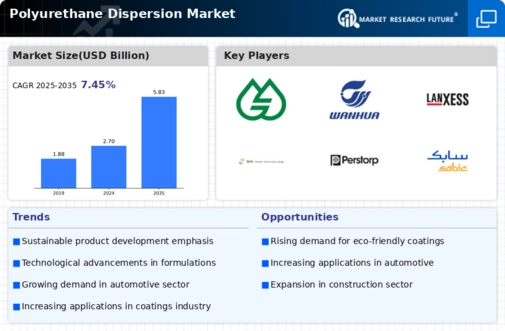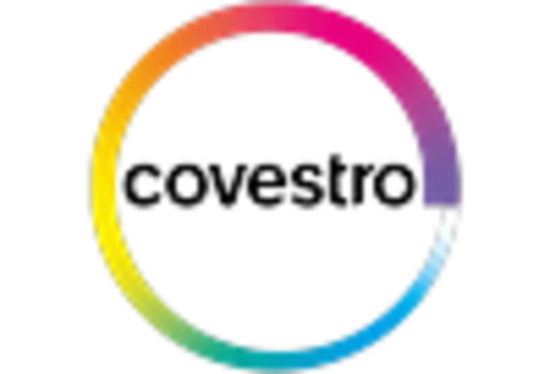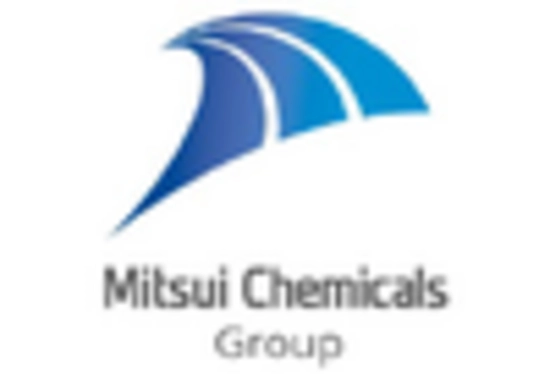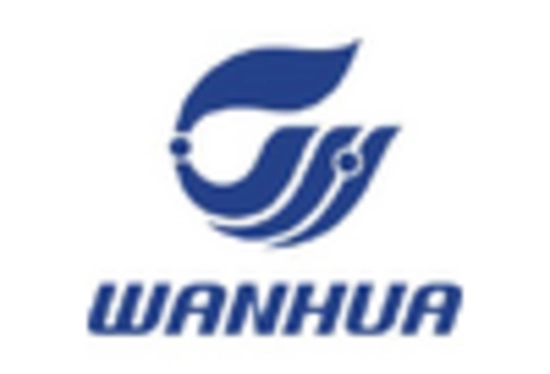-
Report Prologue
-
\r\n
-
\r\n
-
Market Introduction
-
\r\n
-
Definition 16
-
\r\n
-
Scope of the Study 16
-
\r\n
-
List of Assumptions 16
-
\r\n
-
Limitations 16
-
\r\n
-
Market Structure 17
-
\r\n
-
\r\n
-
Research Methodology
-
\r\n
-
Research Process 19
-
\r\n
-
Primary Research 19
-
\r\n
-
Secondary Research 20
-
\r\n
-
Market Size Estimation 20
-
\r\n
-
Forecast Model 21
-
\r\n
-
\r\n
-
Market Dynamics
-
\r\n
-
Introduction 23
-
\r\n
-
Drivers 24
- Increasing incidents of fungal infections 24
- High Growth of Textile and Leather Industry 25
- High Growth of Textile and Leather Industry 26
-
\r\n
-
\r\n
-
\r\n
-
\r\n
-
Restraint 27
- Fluctuating Prices of Raw Material 27
-
\r\n
-
\r\n
-
Opportunity 28
- Stringent Regulations Regarding Environmentally Friendly Products 28
-
\r\n
-
\r\n
-
Trend 28
- Increasing Demand for Water Based Polyurethane Dispersion 28
-
\r\n
-
\r\n
-
\r\n
-
Market Factor Analysis
-
\r\n
-
Supply Chain Analysis 30
- Raw Material Suppliers 30
- Polyurethane Dispersion Manufacturers 31
- Distribution Channel 31
- End-User Industry 31
-
\r\n
-
\r\n
-
\r\n
-
\r\n
-
\r\n
-
Porter's Five Forces Analysis 32
- Threat of New Entrants 32
- Threat of Rivalry 32
- Threat of Substitute 33
- Bargaining Power of Supplier 33
- Bargaining Power of Buyer 33
-
\r\n
-
\r\n
-
\r\n
-
\r\n
-
\r\n
-
\r\n
-
\r\n
-
Global Polyurethane Dispersion Market, By Type
-
\r\n
-
Introduction 35
-
\r\n
-
Solvent Based 36
-
\r\n
-
Water Based 38
-
\r\n
-
\r\n
-
Global Polyurethane Dispersion Market, By Application
-
\r\n
-
Introduction 40
-
\r\n
-
Coatings 42
-
\r\n
-
Adhesives & Sealants 43
-
\r\n
-
Leather Finishing 44
-
\r\n
-
Paper & Textile 45
-
\r\n
-
Fiber Glass Sizing 46
-
\r\n
-
Others 47
-
\r\n
-
\r\n
-
Global Polyurethane Dispersion Market, By Region
-
\r\n
-
Introduction 50
-
\r\n
-
North America 55
- U.S. 58
- Canada 60
-
\r\n
-
\r\n
-
\r\n
-
Europe 63
- Germany 67
- UK 69
- France 71
- Italy 73
- Russia 75
- Rest of Europe 77
-
\r\n
-
\r\n
-
\r\n
-
\r\n
-
\r\n
-
\r\n
-
\r\n
-
Asia Pacific 79
- China 83
- Japan 85
- India 87
- Rest of Asia Pacific 89
-
\r\n
-
\r\n
-
\r\n
-
\r\n
-
\r\n
-
Latin America 91
- Brazil 94
- Mexico 96
- Rest of Latin America 98
-
\r\n
-
\r\n
-
\r\n
-
\r\n
-
Middle East & Africa 101
- UAE 105
- Turkey 107
- Saudi Arabia 109
- Rest of Middle East and Africa 111
-
\r\n
-
\r\n
-
\r\n
-
\r\n
-
\r\n
-
\r\n
-
Competitive Landscape
-
\r\n
-
Introduction 114
-
\r\n
-
Market Strategy Analysis 114
-
\r\n
-
Key Developments of Market Players 115
-
\r\n
-
\r\n
-
Company Profiles
-
\r\n
-
The Lubrizol Corporation 119
- Company Overview 119
- Financials 119
- Products 119
- Strategy 119
- Key Developments 119
-
\r\n
-
\r\n
-
\r\n
-
\r\n
-
\r\n
-
\r\n
-
Michelman, Inc. 120
- Company Overview 120
- Financials 120
- Products 120
- Strategy 120
- Key Developments 120
-
\r\n
-
\r\n
-
\r\n
-
\r\n
-
\r\n
-
\r\n
-
MITSUI CHEMICALS AMERICA, INC. 121
- Company Overview 121
- Financials 121
- Products 121
- Strategy 121
- Key Developments 121
-
\r\n
-
\r\n
-
\r\n
-
\r\n
-
\r\n
-
\r\n
-
Perstorp 122
- Company Overview 122
- Financials 122
- Products 122
- Strategy 122
- Key Developments 122
-
\r\n
-
\r\n
-
\r\n
-
\r\n
-
\r\n
-
\r\n
-
Lamberti S.p.A. 123
- Company Overview 123
- Financials 123
- Products 123
- Strategy 123
- Key Developments 123
-
\r\n
-
\r\n
-
\r\n
-
\r\n
-
\r\n
-
\r\n
-
LANXESS 124
- Company Overview 124
- Financials 124
- Products 124
- Strategy 124
- Key Developments 124
-
\r\n
-
\r\n
-
\r\n
-
\r\n
-
\r\n
-
\r\n
-
Alberdingk Boley 125
- Company Overview 125
- Financials 125
- Products 125
- Strategy 125
- Key Developments 125
-
\r\n
-
\r\n
-
\r\n
-
\r\n
-
\r\n
-
\r\n
-
C. L. Hauthaway & Sons Corp., 126
- Company Overview 126
- Financials 126
- Products 126
- Strategy 126
- Key Developments 126
-
\r\n
-
\r\n
-
\r\n
-
\r\n
-
\r\n
-
\r\n
-
Chase Corporation 127
- Company Overview 127
- Financials 127
- Products 127
- Strategy 127
- Key Developments 127
-
\r\n
-
\r\n
-
\r\n
-
\r\n
-
\r\n
-
\r\n
-
allnex 128
- Company Overview 128
- Financials 128
- Products 128
- Strategy 128
- Key Developments 128
-
\r\n
-
\r\n
-
\r\n
-
\r\n
-
\r\n
-
\r\n
-
Covestro AG 129
- Company Overview 129
- Financials 129
- Products 129
- Strategy 129
- Key Developments 129
-
\r\n
-
\r\n
-
\r\n
-
\r\n
-
\r\n
-
\r\n
-
The Dow Chemical Company 130
- Company Overview 130
- Financials 130
- Products 130
- Strategy 130
- Key Developments 130
-
\r\n
-
\r\n
-
\r\n
-
\r\n
-
\r\n
-
\r\n
-
BASF SE 131
- Company Overview 131
- Financials 131
- Products 131
- Strategy 131
- Key Developments 131
-
\r\n
-
\r\n
-
\r\n
-
\r\n
-
\r\n
-
\r\n
-
3M 132
- Company Overview 132
- Financials 132
- Products 132
- Strategy 132
- Key Developments 132
-
\r\n
-
\r\n
-
\r\n
-
\r\n
-
\r\n
-
\r\n
-
\r\n
-
Conclusion
-
\r\n
-
\r\n
-
List of Tables
-
\r\n
-
MARKET SYNOPSIS 14
-
\r\n
-
GLOBAL POLYURETHANE DISPERSION, BY TYPE, 2020-2027 (USD MILLION) 35
-
\r\n
-
GLOBAL POLYURETHANE DISPERSION MARKET, BY TYPE, 2020-2027 (KILO TONS) 36
-
\r\n
-
GLOBAL POLYURETHANE DISPERSION MARKET FOR SOLVENT BASED, BY TYPE, 2020-2027 (USD MILLION) 37
-
\r\n
-
GLOBAL POLYURETHANE DISPERSIONMARKET FOR SOLVENT BASED, BY TYPE, 2020-2027 (KILO TONS) 37
-
\r\n
-
GLOBAL POLYURETHANE DISPERSIONMARKET FOR WATER BASED, BY TYPE, 2020-2027 (USD MILLION) 38
-
\r\n
-
GLOBAL POLYURETHANE DISPERSIONMARKET FOR WATER BASED, BY TYPE, 2020-2027 (KILO TONS) 38
-
\r\n
-
GLOBAL POLYURETHANE DISPERSION, BY APPLICATION, 2020-2027 (USD MILLION) 41
-
\r\n
-
GLOBAL POLYURETHANE DISPERSION MARKET, BY APPLICATION, 2020-2027 (KILO TONS) 42
-
\r\n
-
GLOBAL POLYURETHANE DISPERSION MARKET FOR COATINGS, BY APPLICATION, 2020-2027 (USD MILLION) 42
-
\r\n
-
GLOBAL POLYURETHANE DISPERSIONMARKET FOR COATINGS, BY APPLICATION, 2020-2027 (KILO TONS) 43
-
\r\n
-
GLOBAL POLYURETHANE DISPERSIONMARKET FOR ADHESIVES & SEALANTS, BY APPLICATION, 2020-2027 (USD MILLION) 43
-
\r\n
-
GLOBAL POLYURETHANE DISPERSIONMARKET FOR ADHESIVES & SEALANTS, BY APPLICATION, 2020-2027 (KILO TONS) 44
-
\r\n
-
GLOBAL POLYURETHANE DISPERSIONMARKET FOR LEATHER FINISHING, BY APPLICATION, 2020-2027 (USD MILLION) 44
-
\r\n
-
GLOBAL POLYURETHANE DISPERSIONMARKET FOR LEATHER FINISHING, BY APPLICATION, 2020-2027 (KILO TONS) 45
-
\r\n
-
GLOBAL POLYURETHANE DISPERSIONMARKET FOR PAPER & TEXTILE, BY APPLICATION, 2020-2027 (USD MILLION) 45
-
\r\n
-
GLOBAL POLYURETHANE DISPERSIONMARKET FOR PAPER & TEXTILE, BY APPLICATION, 2020-2027 (KILO TONS) 46
-
\r\n
-
GLOBAL POLYURETHANE DISPERSION MARKET FOR FIBER GLASS SIZING, BY APPLICATION, 2020-2027 (USD MILLION) 46
-
\r\n
-
GLOBAL POLYURETHANE DISPERSION MARKET FOR FIBER GLASS SIZING, BY APPLICATION, 2020-2027 (KILO TONS) 47
-
\r\n
-
GLOBAL POLYURETHANE DISPERSION MARKET FOR OTHERS, BY APPLICATION, 2020-2027 (USD MILLION) 47
-
\r\n
-
GLOBAL POLYURETHANE DISPERSION MARKET FOR OTHERS, BY APPLICATION, 2020-2027 (KILO TONS) 48
-
\r\n
-
GLOBAL POLYURETHANE DISPERSION MARKET, BY REGION, 2020-2027 (USD MILLION) 51
-
\r\n
-
GLOBAL POLYURETHANE DISPERSION MARKET, BY REGION, 2020-2027 (KILO TONS) 52
-
\r\n
-
GLOBAL POLYURETHANE DISPERSION MARKET, BY TYPE, 2020-2027 ( USD MILLION) 53
-
\r\n
-
GLOBAL POLYURETHANE DISPERSION MARKET, BY TYPE, 2020-2027 (KILO TONS) 53
-
\r\n
-
GLOBAL POLYURETHANE DISPERSION MARKET, BY APPLICATION, 2020-2027 ( USD MILLION) 53
-
\r\n
-
GLOBAL POLYURETHANE DISPERSION MARKET, BY APPLICATION, 2020-2027 (KILO TONS) 54
-
\r\n
-
NORTH AMERICA POLYURETHANE DISPERSION MARKET, BY COUNTRY, 2020-2027 (USD MILLION) 56
-
\r\n
-
NORTH AMERICA POLYURETHANE DISPERSIONMARKET, BY COUNTRY, 2020-2027 (KILO TONS) 56
-
\r\n
-
NORTH AMERICA POLYURETHANE DISPERSION MARKET, BY TYPE, 2020-2027 ( USD MILLION) 56
-
\r\n
-
NORTH AMERICA POLYURETHANE DISPERSION MARKET, BY TYPE, 2020-2027 (KILO TONS) 57
-
\r\n
-
NORTH AMERICA POLYURETHANE DISPERSION MARKET, BY APPLICATION, 2020-2027 (USD MILLION) 57
-
\r\n
-
NORTH AMERICA POLYURETHANE DISPERSION MARKET, BY APPLICATION, 2020-2027 (KILO TONS) 58
-
\r\n
-
U.S. POLYURETHANE DISPERSION MARKET, BY TYPE, 2020-2027 ( USD MILLION) 58
-
\r\n
-
U.S. POLYURETHANE DISPERSION MARKET, BY TYPE, 2020-2027 (KILO TONS) 59
-
\r\n
-
U.S. POLYURETHANE DISPERSION MARKET, BY APPLICATION, 2020-2027 (USD MILLION) 59
-
\r\n
-
U.S. POLYURETHANE DISPERSIONMARKET, BY APPLICATION, 2020-2027 (KILO TONS) 60
-
\r\n
-
CANADA POLYURETHANE DISPERSION MARKET, BY TYPE, 2020-2027 ( USD MILLION) 60
-
\r\n
-
CANADA POLYURETHANE DISPERSION MARKET, BY TYPE, 2020-2027 (KILO TONS) 61
-
\r\n
-
CANADA POLYURETHANE DISPERSIONMARKET, BY APPLICATION, 2020-2027 (USD MILLION) 61
-
\r\n
-
CANADA POLYURETHANE DISPERSIONMARKET, BY APPLICATION, 2020-2027 (KILO TONS) 62
-
\r\n
-
EUROPE POLYURETHANE DISPERSION MARKET, BY COUNTRY, 2020-2027 (USD MILLION) 64
-
\r\n
-
EUROPE POLYURETHANE DISPERSION MARKET, BY COUNTRY, 2020-2027 (KILO TONS) 64
-
\r\n
-
EUROPE POLYURETHANE DISPERSION MARKET, BY TYPE, 2020-2027 ( USD MILLION) 65
-
\r\n
-
EUROPE POLYURETHANE DISPERSION MARKET, BY TYPE, 2020-2027 (KILO TONS) 65
-
\r\n
-
EUROPE POLYURETHANE DISPERSION MARKET, BY APPLICATION, 2020-2027 (USD MILLION) 66
-
\r\n
-
EUROPE POLYURETHANE DISPERSION MARKET, BY APPLICATION, 2020-2027 (KILO TONS) 66
-
\r\n
-
GERMANY POLYURETHANE DISPERSION MARKET, BY TYPE, 2020-2027 ( USD MILLION) 67
-
\r\n
-
GERMANY POLYURETHANE DISPERSION MARKET, BY TYPE, 2020-2027 (KILO TONS) 67
-
\r\n
-
GERMANY POLYURETHANE DISPERSION MARKET, BY APPLICATION, 2020-2027 (USD MILLION) 68
-
\r\n
-
GERMANY POLYURETHANE DISPERSION MARKET, BY APPLICATION, 2020-2027 (KILO TONS) 68
-
\r\n
-
UK POLYURETHANE DISPERSION MARKET, BY TYPE, 2020-2027 ( USD MILLION) 69
-
\r\n
-
UK POLYURETHANE DISPERSION MARKET, BY TYPE, 2020-2027 (KILO TONS) 69
-
\r\n
-
UK POLYURETHANE DISPERSIONMARKET, BY APPLICATION, 2020-2027 (USD MILLION) 70
-
\r\n
-
UK POLYURETHANE DISPERSIONMARKET, BY APPLICATION, 2020-2027 (KILO TONS) 70
-
\r\n
-
FRANCE POLYURETHANE DISPERSION MARKET, BY TYPE, 2020-2027 ( USD MILLION) 71
-
\r\n
-
FRANCE POLYURETHANE DISPERSION MARKET, BY TYPE, 2020-2027 (KILO TONS) 71
-
\r\n
-
FRANCE POLYURETHANE DISPERSION MARKET, BY APPLICATION, 2020-2027 (USD MILLION) 72
-
\r\n
-
FRANCE POLYURETHANE DISPERSION MARKET, BY APPLICATION, 2020-2027 (KILO TONS) 72
-
\r\n
-
ITALY POLYURETHANE DISPERSION MARKET, BY TYPE, 2020-2027 ( USD MILLION) 73
-
\r\n
-
ITALY POLYURETHANE DISPERSION MARKET, BY TYPE, 2020-2027 (KILO TONS) 73
-
\r\n
-
ITALY POLYURETHANE DISPERSION MARKET, BY APPLICATION, 2020-2027 (USD MILLION) 74
-
\r\n
-
ITALY POLYURETHANE DISPERSION MARKET, BY APPLICATION, 2020-2027 (KILO TONS) 74
-
\r\n
-
RUSSIA POLYURETHANE DISPERSION MARKET, BY TYPE, 2020-2027 ( USD MILLION) 75
-
\r\n
-
RUSSIA POLYURETHANE DISPERSION MARKET, BY TYPE, 2020-2027 (KILO TONS) 75
-
\r\n
-
RUSSIA POLYURETHANE DISPERSION MARKET, BY APPLICATION, 2020-2027 (USD MILLION) 76
-
\r\n
-
RUSSIA POLYURETHANE DISPERSION MARKET, BY APPLICATION, 2020-2027 (KILO TONS) 76
-
\r\n
-
REST OF EUROPE POLYURETHANE DISPERSION MARKET, BY TYPE, 2020-2027 ( USD MILLION) 77
-
\r\n
-
REST OF EUROPE POLYURETHANE DISPERSION MARKET, BY TYPE, 2020-2027 (KILO TONS) 77
-
\r\n
-
REST OF EUROPE POLYURETHANE DISPERSION MARKET, BY APPLICATION, 2020-2027 (USD MILLION) 78
-
\r\n
-
REST OF EUROPE POLYURETHANE DISPERSION MARKET, BY APPLICATION, 2020-2027 (KILO TONS) 78
-
\r\n
-
ASIA PACIFIC POLYURETHANE DISPERSIONMARKET, BY COUNTRY, 2020-2027 (USD MILLION) 80
-
\r\n
-
ASIA PACIFIC POLYURETHANE DISPERSIONMARKET, BY COUNTRY, 2020-2027 (KILO TONS) 80
-
\r\n
-
ASIA PACIFIC POLYURETHANE DISPERSION MARKET, BY TYPE, 2020-2027 ( USD MILLION) 81
-
\r\n
-
ASIA PACIFIC POLYURETHANE DISPERSION MARKET, BY TYPE, 2020-2027 (KILO TONS) 81
-
\r\n
-
ASIA PACIFIC POLYURETHANE DISPERSION MARKET, BY APPLICATION, 2020-2027 (USD MILLION) 82
-
\r\n
-
ASIA PACIFIC POLYURETHANE DISPERSION MARKET, BY APPLICATION, 2020-2027 (KILO TONS) 82
-
\r\n
-
CHINA POLYURETHANE DISPERSION MARKET, BY TYPE, 2020-2027 ( USD MILLION) 83
-
\r\n
-
CHINA POLYURETHANE DISPERSION MARKET, BY TYPE, 2020-2027 (KILO TONS) 83
-
\r\n
-
CHINA POLYURETHANE DISPERSIONMARKET, BY APPLICATION, 2020-2027 (USD MILLION) 84
-
\r\n
-
CHINA POLYURETHANE DISPERSIONMARKET, BY APPLICATION, 2020-2027 (KILO TONS) 84
-
\r\n
-
JAPAN POLYURETHANE DISPERSION MARKET, BY TYPE, 2020-2027 ( USD MILLION) 85
-
\r\n
-
JAPAN POLYURETHANE DISPERSION MARKET, BY TYPE, 2020-2027 (KILO TONS) 85
-
\r\n
-
JAPAN POLYURETHANE DISPERSIONMARKET, BY APPLICATION, 2020-2027 (USD MILLION) 86
-
\r\n
-
JAPAN POLYURETHANE DISPERSIONMARKET, BY APPLICATION, 2020-2027 (KILO TONS) 86
-
\r\n
-
INDIA POLYURETHANE DISPERSION MARKET, BY TYPE, 2020-2027 ( USD MILLION) 87
-
\r\n
-
INDIA POLYURETHANE DISPERSION MARKET, BY TYPE, 2020-2027 (KILO TONS) 87
-
\r\n
-
INDIA POLYURETHANE DISPERSION MARKET, BY APPLICATION, 2020-2027 (USD MILLION) 88
-
\r\n
-
INDIA POLYURETHANE DISPERSION MARKET, BY APPLICATION, 2020-2027 (KILO TONS) 88
-
\r\n
-
REST OF ASIA PACIFIC POLYURETHANE DISPERSION MARKET, BY TYPE, 2020-2027 ( USD MILLION) 89
-
\r\n
-
REST OF ASIA PACIFIC POLYURETHANE DISPERSION MARKET, BY TYPE, 2020-2027 (KILO TONS) 89
-
\r\n
-
REST OF ASIA PACIFIC POLYURETHANE DISPERSION MARKET, BY APPLICATION, 2020-2027 (USD MILLION) 90
-
\r\n
-
REST OF ASIA PACIFIC POLYURETHANE DISPERSION MARKET, BY APPLICATION, 2020-2027 (KILO TONS) 90
-
\r\n
-
LATIN AMERICA POLYURETHANE DISPERSION MARKET, BY COUNTRY, 2020-2027 (USD MILLION) 92
-
\r\n
-
LATIN AMERICA POLYURETHANE DISPERSION MARKET, BY COUNTRY, 2020-2027 (KILO TONS) 92
-
\r\n
-
LATIN AMERICA POLYURETHANE DISPERSION MARKET, BY TYPE, 2020-2027 ( USD MILLION) 92
-
\r\n
-
LATIN AMERICA POLYURETHANE DISPERSION MARKET, BY TYPE, 2020-2027 (KILO TONS) 93
-
\r\n
-
LATIN AMERICA POLYURETHANE DISPERSION MARKET, BY APPLICATION, 2020-2027 (USD MILLION) 93
-
\r\n
-
LATIN AMERICA POLYURETHANE DISPERSIONMARKET, BY APPLICATION, 2020-2027 (KILO TONS) 94
-
\r\n
-
BRAZIL POLYURETHANE DISPERSION MARKET, BY TYPE, 2020-2027 ( USD MILLION) 94
-
\r\n
-
BRAZIL POLYURETHANE DISPERSION MARKET, BY TYPE, 2020-2027 (KILO TONS) 95
-
\r\n
-
BRAZIL POLYURETHANE DISPERSION MARKET, BY APPLICATION, 2020-2027 (USD MILLION) 95
-
\r\n
-
BRAZIL POLYURETHANE DISPERSION MARKET, BY APPLICATION, 2020-2027 (KILO TONS) 96
-
\r\n
-
MEXICO POLYURETHANE DISPERSION MARKET, BY TYPE, 2020-2027 ( USD MILLION) 96
-
\r\n
-
MEXICO POLYURETHANE DISPERSION MARKET, BY TYPE, 2020-2027 (KILO TONS) 97
-
\r\n
-
MEXICO POLYURETHANE DISPERSION MARKET, BY APPLICATION, 2020-2027 (USD MILLION) 97
-
\r\n
-
MEXICO POLYURETHANE DISPERSION MARKET, BY APPLICATION, 2020-2027 (KILO TONS) 98
-
\r\n
-
REST OF LATIN AMERICA POLYURETHANE DISPERSION MARKET, BY TYPE, 2020-2027 ( USD MILLION) 98
-
\r\n
-
REST OF LATIN AMERICA POLYURETHANE DISPERSION MARKET, BY TYPE, 2020-2027 (KILO TONS) 99
-
\r\n
-
REST OF LATIN AMERICA POLYURETHANE DISPERSION MARKET, BY APPLICATION, 2020-2027 (USD MILLION) 99
-
\r\n
-
REST OF LATIN AMERICA POLYURETHANE DISPERSION MARKET, BY APPLICATION, 2020-2027 (KILO TONS) 100
-
\r\n
-
MIDDLE EAST AND AFRICA POLYURETHANE DISPERSION MARKET, BY COUNTRY, 2020-2027 (USD MILLION) 102
-
\r\n
-
MIDDLE EAST AND AFRICA POLYURETHANE DISPERSION MARKET, BY COUNTRY, 2020-2027 (KILO TONS) 102
-
\r\n
-
MIDDLE EAST AND AFRICA POLYURETHANE DISPERSION MARKET, BY TYPE, 2020-2027 ( USD MILLION) 103
-
\r\n
-
MIDDLE EAST AND AFRICA POLYURETHANE DISPERSION MARKET, BY TYPE, 2020-2027 (KILO TONS) 103
-
\r\n
-
MIDDLE EAST AND AFRICA POLYURETHANE DISPERSION MARKET, BY APPLICATION, 2020-2027 (USD MILLION) 104
-
\r\n
-
MIDDLE EAST AND AFRICA POLYURETHANE DISPERSIONMARKET, BY APPLICATION, 2020-2027 (KILO TONS) 104
-
\r\n
-
UAE POLYURETHANE DISPERSION MARKET, BY TYPE, 2020-2027 ( USD MILLION) 105
-
\r\n
-
UAE POLYURETHANE DISPERSION MARKET, BY TYPE, 2020-2027 (KILO TONS) 105
-
\r\n
-
UAE POLYURETHANE DISPERSION MARKET, BY APPLICATION, 2020-2027 (USD MILLION) 106
-
\r\n
-
UAE POLYURETHANE DISPERSION MARKET, BY APPLICATION, 2020-2027 (KILO TONS) 106
-
\r\n
-
TURKEY POLYURETHANE DISPERSION MARKET, BY TYPE, 2020-2027 ( USD MILLION) 107
-
\r\n
-
TURKEY POLYURETHANE DISPERSION MARKET, BY TYPE, 2020-2027 (KILO TONS) 107
-
\r\n
-
TURKEY POLYURETHANE DISPERSIONMARKET, BY APPLICATION, 2020-2027 (USD MILLION) 108
-
\r\n
-
TURKEY POLYURETHANE DISPERSIONMARKET, BY APPLICATION, 2020-2027 (KILO TONS) 108
-
\r\n
-
SAUDI ARABIA POLYURETHANE DISPERSION MARKET, BY TYPE, 2020-2027 ( USD MILLION) 109
-
\r\n
-
SAUDI ARABIA POLYURETHANE DISPERSION MARKET, BY TYPE, 2020-2027 (KILO TONS) 109
-
\r\n
-
SAUDI ARABIA POLYURETHANE DISPERSION MARKET, BY APPLICATION, 2020-2027 (USD MILLION) 110
-
\r\n
-
SAUDI ARABIA POLYURETHANE DISPERSION MARKET, BY APPLICATION, 2020-2027 (KILO TONS) 110
-
\r\n
-
REST OF MIDDLE EAST AND AFRICA POLYURETHANE DISPERSION MARKET, BY TYPE, 2020-2027 ( USD MILLION) 111
-
\r\n
-
REST OF MIDDLE EAST AND AFRICA POLYURETHANE DISPERSION MARKET, BY TYPE, 2020-2027 (KILO TONS) 111
-
\r\n
-
REST OF MIDDLE EAST AND AFRICA POLYURETHANE DISPERSION MARKET, BY APPLICATION, 2020-2027 (USD MILLION) 112
-
\r\n
-
REST OF MIDDLE EAST AND AFRICA POLYURETHANE DISPERSION MARKET, BY APPLICATION, 2020-2027 (KILO TONS) 112
-
\r\n
-
KEY DEVELOPMENTS 115
-
\r\n
-
\r\n
-
-
\r\n
-
\r\n
-
List of Figures
-
\r\n
-
RESEARCH PROCESS OF MRFR 19
-
\r\n
-
TOP DOWN & BOTTOM UP APPROACH 20
-
\r\n
-
SUPPLY CHAIN ANALYSIS 30
-
\r\n
-
PORTER’S FIVE FORCES ANALYSIS OF GLOBAL POLYURETHANE DISPERSION MARKET 32
-
\r\n
-
GLOBAL POLYURETHANE DISPERSION MARKET, BY TYPE, 2020-2027 (USD MILLION) 35
-
\r\n
-
GLOBAL POLYURETHANE DISPERSION MARKET, BY TYPE, 2020-2027 (KILO TONS) 36
-
\r\n
-
GLOBAL POLYURETHANE DISPERSION MARKET, BY APPLICATION, 2020-2027 (USD MILLION) 40
-
\r\n
-
GLOBAL POLYURETHANE DISPERSION MARKET, BY APPLICATION, 2020-2027 (KILO TONS) 41
-
\r\n
-
GLOBAL POLYURETHANE DISPERSION MARKET BY REGION, 2020-2027 (USD MILLION) 50
-
\r\n
-
GLOBAL POLYURETHANE DISPERSION MARKET BY REGION USD MILLION (%) (2020) 51
-
\r\n
-
GLOBAL POLYURETHANE DISPERSION MARKET BY REGION, 2020-2027 (KILO TONS) 52
-
\r\n
-
MARKET STRATEGY ANALYSIS 114
-
\r\n









Leave a Comment